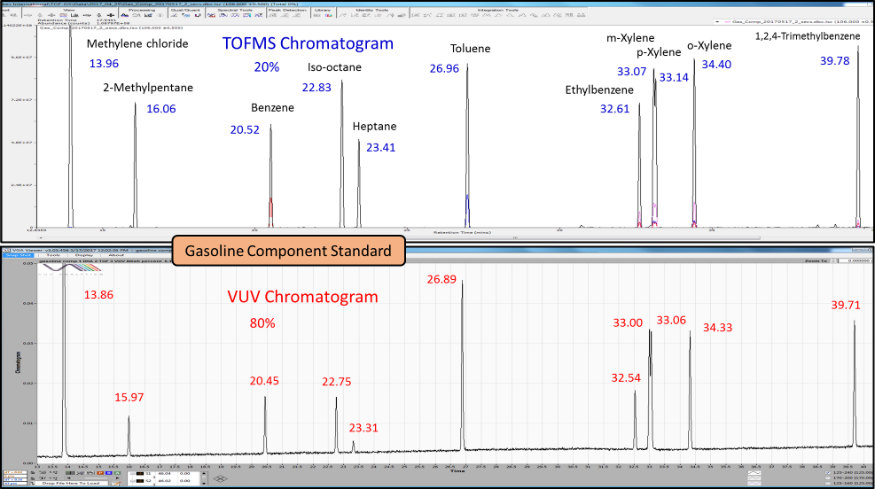Published Jack Cochran on June 1, 2017
As humans, we crave the comfort of the familiar, a friend of mine told me long ago. It’s true, but I’ve always been willing to stretch away from this old proverb when evaluating exciting new analytical instrumentation for gas chromatography. I guess I’m what you call an “early adopter”. That said, any new equipment must address an unsolved problem, while simultaneously having its data quality verified by previous or currently used technology. If you read my last blog post, you may know already where I’m going with this introduction – efficiently harnessing the complementary nature of both vacuum ultraviolet spectroscopy (VUV) and mass spectrometry (MS) as gas chromatography detectors.
As I get into the technical details for this post I want to put in a plug for VUV Analytics Applications Scientist James Diekmann III, who did all the work. As part of a finished gasoline and gasoline-range detailed hydrocarbon analysis project, James used a Restek 100m x 0.25mm x 0.50µm Rtx-DHA GC column connected, post-GC column, to a microfluidic splitting device from SepSolve Analytical. This simple “Y” splitter had one transfer line of 5m x 0.10mm uncoated, deactivated fused silica tubing going to a Markes International Bench-TOF Select time-of-flight mass spectrometer (TOFMS) and another transfer line of 5m x 0.15mm uncoated, deactivated fused silica tubing connected to our VGA-100 VUV detector such that mass spectra and absorbance spectra could be collected simultaneously. Not complicated, and all the “stuff” is off-the-shelf and easily installed. One GC inlet – one GC column – a Y splitter – two transfer lines – two powerful spectral detectors.
The data we’ve generated so far is easy to interpret given that the retention times for both TOFMS and VUV are very similar, with just a slight constant offset (Figure 1). This same post-GC column split approach can be extended to other GC detectors (e.g., FID, SCD, TCD, etc.).

Figure 1. Gasoline component standard chromatograms collected simultaneously from a 20:80 post-GC column split to TOFMS and VUV detectors.
What’s the benefit of collecting mass and absorbance spectra on the same GC system? First, mass spectrometry is still the gold standard for qualitative and quantitative analysis of many samples. However, VUV offers advantages over MS including (1) VUV’s ability to differentiate coeluting isomeric compounds based on their absorbance spectra, (2) VUV’s use of spectral information to provide compound class characterization as described in ASTM D8071, Standard Test Method for Determination of Hydrocarbon Group Types and Select Hydrocarbon and Oxygenate Compounds in Automotive Spark-Ignition Engine Fuel Using Gas Chromatography with Vacuum Ultraviolet Absorption Spectroscopy Detection (GC-VUV), and (3) VUV’s capacity to provide more uniform response factors for unknown analyte quantification.
Hopefully what I’ve got you thinking about is the possibilities of richer spectral data sets that result from coupling a familiar frame of reference with powerful new analytical technology. Mass spectrometry, something many of you are already using daily in your lab, can partner with vacuum ultraviolet spectroscopy to provide complete compound identification and quantitation. We’ll be showing some of this proof of concept data at ASMS 2017 in Booth #311. Feel free to contact us for more information about hyphenated gc methods, or if you would like copies of the poster after the show.







Leave a Reply